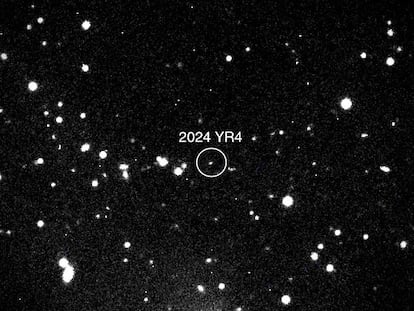Sodom and Gomorrah were not destroyed by the impact of an extraterrestrial object
The journal ‘Scientific Reports’ has retracted the study that claimed a massive airburst devastated a city in the Jordan River Valley 3,600 years ago, inspiring the biblical tale of the Sodomites

The story made headlines around the world. “A massive meteor may have destroyed the biblical city of Sodom,” was the headline in Forbes magazine. A team of U.S. scientists had just presented evidence suggesting that “a cosmic airburst” obliterated Tall el-Hammam, a town located in the Jordan River Valley, in present-day Jordan, around 3,600 years ago.
The researchers shared images of a “destruction layer” uncovered at the archaeological site — complete with molten metals indicating temperatures that may have exceeded 2,000 degrees Celsius (3,632ºF). They proposed that a cloud of salt, hurled into the air by the explosion, may have rendered the region uninhabitable for centuries. According to the team, the memory of this cataclysm could have inspired the biblical tale of Sodom’s destruction.
The scientific journal Scientific Reports, which originally published the study in September 2021, retracted it this Thursday after editors found “clear errors” and concluded that the data no longer supported the authors’ conclusions.
In the Bible, the Christian God “rained upon Sodom and upon Gomorrah brimstone and fire” because their inhabitants “were wicked and sinning greatly against the Lord.” The biblical account is confusing, but has traditionally been interpreted to suggest that the men of Sodom engaged freely in same-sex relations.
The Quran is more direct, quoting the shepherd Lot as saying: “Will ye commit abomination such as no creature ever did before you? Indeed, you approach men with desire, instead of women. Lo! ye come with lust unto men instead of women. Nay, but ye are wanton folk.” According to scripture, Lot’s wife looked back at the devastation, and was turned into a pillar of salt.
The now-retracted study was authored by several founding members of the Comet Research Group, a team of mostly U.S. scientists whose stated mission is to “find evidence about comet impacts and raise awareness about them before your city is next,” as stated on their website. The group’s director, geologist Allen West, is outraged over the retraction. “I and the other co-authors strongly disagree with the retraction,” he tells EL PAÍS.
West — known for his frequent appearances in documentaries on historical catastrophes — acknowledges that, as cosmologist Carl Sagan famously said, “extraordinary claims require extraordinary proof.” But he also cites another Sagan quote: “The suppression of uncomfortable ideas may be common in religion or in politics, but it is not the path to knowledge, and there’s no place for it in the endeavor of science.”
West contends that “a small but vocal group of scientists has actively sought to stifle discussion on the Tall el-Hammam airburst.” He and his colleagues plan to republish the study with updated findings, including “new data on the directionality of the blast wave and shocked quartz ” found in the soil of the site.

The founders of the Comet Research Group are convinced that an airburst occurred at the site in Jordan, one even larger than the 1908 explosion over Siberia’s Tunguska region, where an extraterrestrial object disintegrated in the atmosphere, unleashing energy said to be “a thousand times greater” than the Hiroshima atomic bomb.
“The critics thought that they could suppress this discussion, but they failed. We are simply going around them so that the debate about these extremely dangerous airbursts can continue,” says West.
The journal that published their study, Scientific Reports, is part of the same publishing group as Nature, widely regarded as a gold standard in global scientific publishing. But the quality of the two journals differs significantly. Nature is elite. Scientific Reports, by contrast, is the most prolific scientific journal in the world, publishing more than 20,000 papers a year.
German expert Stefanie Haustein has estimated that the journal generated €100 million ($113 million) over four years, thanks to fees charged to authors — about €2,400 ($2,730) per article — for open-access publication. Under this model, many journals have a built-in, perverse incentive: the more studies they publish, the more revenue they generate, regardless of quality.
The initial announcement that a cosmic airburst may have inspired the biblical story of Sodom stirred immediate controversy. But the editor-in-chief of Scientific Reports, chemist Rafal Marszalek, defends the actions taken over the past four years. “This was a complex case for which differing concerns emerged over many months, with the final concerns raised undermining the conclusions of the paper and necessitating retraction,” he explains to EL PAÍS.
As early as 2022, the journal had identified what it described as “an inappropriate level of manipulation” in dozens of images associated with the alleged impact. That same year, U.S. geologists Steven Jaret, from the American Museum of Natural History, and Robert Scott Harris, from the University of Georgia, argued that the supposed minerals melted by a cosmic explosion could instead be remnants of ceramic vessels fired by the inhabitants of Tall el-Hammam.
Marszalek says that the re-evaluation of the study was based strictly on the validity of the results, “never on the ideological positions of any of the parties involved.”
Two days ago, Scientific Reports published a new analysis by independent experts Andy Bruno and Mark Boslough, from Indiana University and the University of New Mexico, respectively. The article addressed the “misunderstandings” surrounding the Tunguska explosion, which they say led to “erroneous interpretations” of the evidence at Tall el-Hammam.
Bruno and Boslough criticized the Comet Research Group for accepting false data that had been circulating for decades — such as the claim that the Tunguska event toppled more than 80 million trees in the Siberian taiga.
In their view, even if a similar event had occurred in Jordan, it would not have been sufficient to cause the destruction described by West and his colleagues. Marszalek agrees, stating that the new analysis “demonstrates clear errors” and confirms longstanding concerns. “The editors therefore no longer have confidence that the conclusions presented are reliable and so have taken the decision to retract the paper,” he concludes.
Sign up for our weekly newsletter to get more English-language news coverage from EL PAÍS USA Edition
Tu suscripción se está usando en otro dispositivo
¿Quieres añadir otro usuario a tu suscripción?
Si continúas leyendo en este dispositivo, no se podrá leer en el otro.
FlechaTu suscripción se está usando en otro dispositivo y solo puedes acceder a EL PAÍS desde un dispositivo a la vez.
Si quieres compartir tu cuenta, cambia tu suscripción a la modalidad Premium, así podrás añadir otro usuario. Cada uno accederá con su propia cuenta de email, lo que os permitirá personalizar vuestra experiencia en EL PAÍS.
¿Tienes una suscripción de empresa? Accede aquí para contratar más cuentas.
En el caso de no saber quién está usando tu cuenta, te recomendamos cambiar tu contraseña aquí.
Si decides continuar compartiendo tu cuenta, este mensaje se mostrará en tu dispositivo y en el de la otra persona que está usando tu cuenta de forma indefinida, afectando a tu experiencia de lectura. Puedes consultar aquí los términos y condiciones de la suscripción digital.
More information
Archived In
Últimas noticias
Christmas loses its festive spirit: ICE fears cast shadow over religious celebrations
‘Sleepless City’: The light of cinema illuminates Madrid’s Cañada Real shantytown
The new language of the workplace: Knowing how to ask AI questions is more important than using it
All the effects of gentrification in one corner of Mexico’s Colonia Roma
Most viewed
- Families demand repatriation of bodies of Colombians who died in Ukraine: ‘This war is a slaughterhouse for foreigners’
- The low-cost creative revolution: How technology is making art accessible to everyone
- Liset Menéndez de la Prida, neuroscientist: ‘It’s not normal to constantly seek pleasure; it’s important to be bored, to be calm’
- Christian Louboutin: ‘Young people don’t want to be like their parents. And if their parents wear sneakers, they’re going to look for something else’
- ‘El Limones’ and the growing union disguise of Mexican organized crime











































